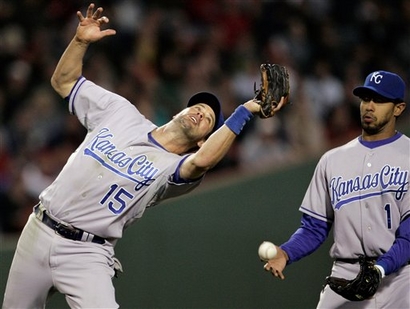
Baseball Prospectus' Joe Sheehan has a column this morning arguing that some of Cliff Lee's success this season is due to the fact that he has faced much softer competition than his chief competitor in the AL Cy Young race, Roy Halladay. This sounded awfully familiar to me, since I had spent the better part of last week arguing that exact point in two different forums after some Cleveland fans got on my case for supposedly belittling Lee's accomplishments after he won his 20th game.
It turns out, however, that Sheehan's argument is based on the hitters that Lee and Halladay have faced, whereas my argument had to do with the starting pitchers who had opposed them. Here's Joe:
If it's not as clear to you as you might like it to be, let me help you out this way: The average EqA rank for Lee's opponents is about 19th, while Roy's opposition has averaged a rank just under 11th in the majors. Right now, for example, Baltimore ranks 11th in MLB in EqA, and they've averaged 5.1 runs per game. Houston ranks 19th in EqA, with just 4.47 R/G. The Runs Scored difference is exaggerated by their respective park effects, but you get the picture.
Cliff Lee has made 28 starts this season, Roy Halladay 29. Of those, 13 are in-common starts: the A’s, Rays and Rangers twice, and the Angels, White Sox, Reds, Royals, Twins, Yankees and Mariners once. Those starts cancel out. Of the remaining starts, there seems to be a very wide gap in the caliber of competition, enough to at least mention. Of the 15 starts Cliff Lee does not have in common with Halladay, nine have come against teams in the bottom third in offense, as ranked by team EqA, and none have come against a team ranked in the top six.
[...]Let me run the data this way, because I think it illustrates the point. The following numbers are the team EqA ranks for each not-in-common opponent, highest to lowest.
Halladay: 3, 4, 4, 4, 9, 9, 9, 11, 11, 14, 14, 14, 14, 17, 18, 18
Lee: 7, 7, 7, 12, 13, 13, 21, 22, 22, 25, 26, 27, 28, 28, 28
It helps if you read those numbers right to left. It’s clear from this data that Cliff Lee has seen a significantly inferior set of opponents than Halladay has.
This average, however, is a disservice to you, as it does not sufficiently express the disparity between these pitchers' competition. Over the course of 15 starts, even if we took those Runs/Game numbers at face value, we'd have a difference of only 9 or 10 runs total, far less than one per game. If you look at Equivalent Runs (BP's attempt to normalize and neutralize for everything under the sun) the difference between 11th and 19th is more like 3 runs over 15 starts, i.e. not much.
This of course does not tell the whole picture, which is probably why Joe didn't present it that way. Halladay and Lee have not faced these "averaged" teams 15 or 16 times. They've faced actual teams, and the teams they've faced have been very different in terms of their offensive prowess. This helps to explain why Lee's ERA is lower than Halladay's. He's capitalized on his comparatively soft schedule.
My arguments last week, in the comments section of my blog and of the post on Bleacher Report, centered around Lee and Halladay's respective opponents on the pitching mound, i.e. the starters their teammates had to face. One of the main reasons that lee is now 21-2 is that his teammates score almost six runs per game when he pitches, while Halladay gets only 4.75 R/G.
Looking at starting pitchers, these two have only five opponents in common: Zach Greinke, James Shields, Chien-Ming Wang, Sidney Ponson, and Matt Garza. If you take them out of the mix, the aggregate records of their respective foes are as follows:
Lee: 156-174, 4.60 ERA, 1.41 WHIP, 2.1 K/W
Roy: 195-176, 4.35 ERA, 1.37 WHIP, 2.3 K/W
The biggest difference here is the W/L records, though with enough data recovery there are notable (if not enormous) differences in all the pitching numbers. (These may be bigger if we were to adjust for park factors and such, but this is too time consuming as it is.) Lee has faced twice as many 10+ game losers as Halladay has (10 to 5), while Halladay has faced several more 10+ game winners (11 to 7), and this naturally leads us back to Sheehan's analysis, of how much tougher the offense has been against Halladay.
It may look like Lee has pitched slightly better overall, but the weak opposition on offense has helped his ERA tremendously, and the huge amount of run support he's gotten, thanks to facing some inferior pitchers, has helped a lot. Give Halladay 6 Runs per game and he's 22-5 instead of 18-9, and suddenly we've got a real race for the CYA.
Unfortunately, the BBWAA voters like shiny objects such as a 21-2 record, and rarely pay attention to things like how many times a pitcher gets to face the horrendous Kansas City Royals (hint: four). Neither do they fret much over whether Dontrelle Willis or Livan Hernandez or Clayton Richard or Chris Lambert or Carlos Silva were as tough to beat as Jose Contreras and and Josh Beckett and Andy Pettitte and Rich Harden and Jon Lackey. (Hint: No.) They just look at the pretty numbers in the newspaper and then vote whomever the heck they feel like voting. Which, this year, will undoubtedly and unfortunately be Cliff Lee.
I'm not saying that they shouldn't vote for him, just that they ought to think about the process a little more than they probably will.


















